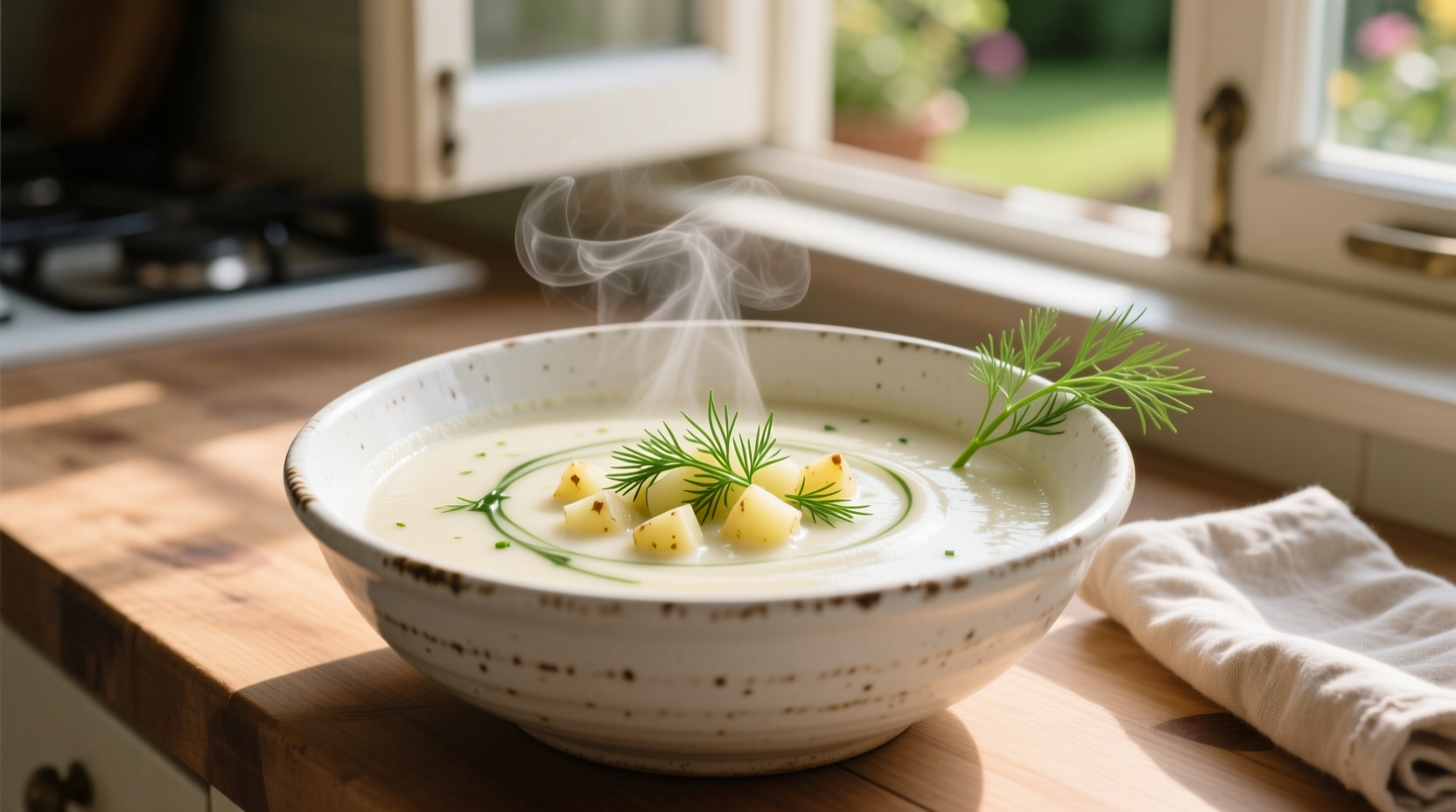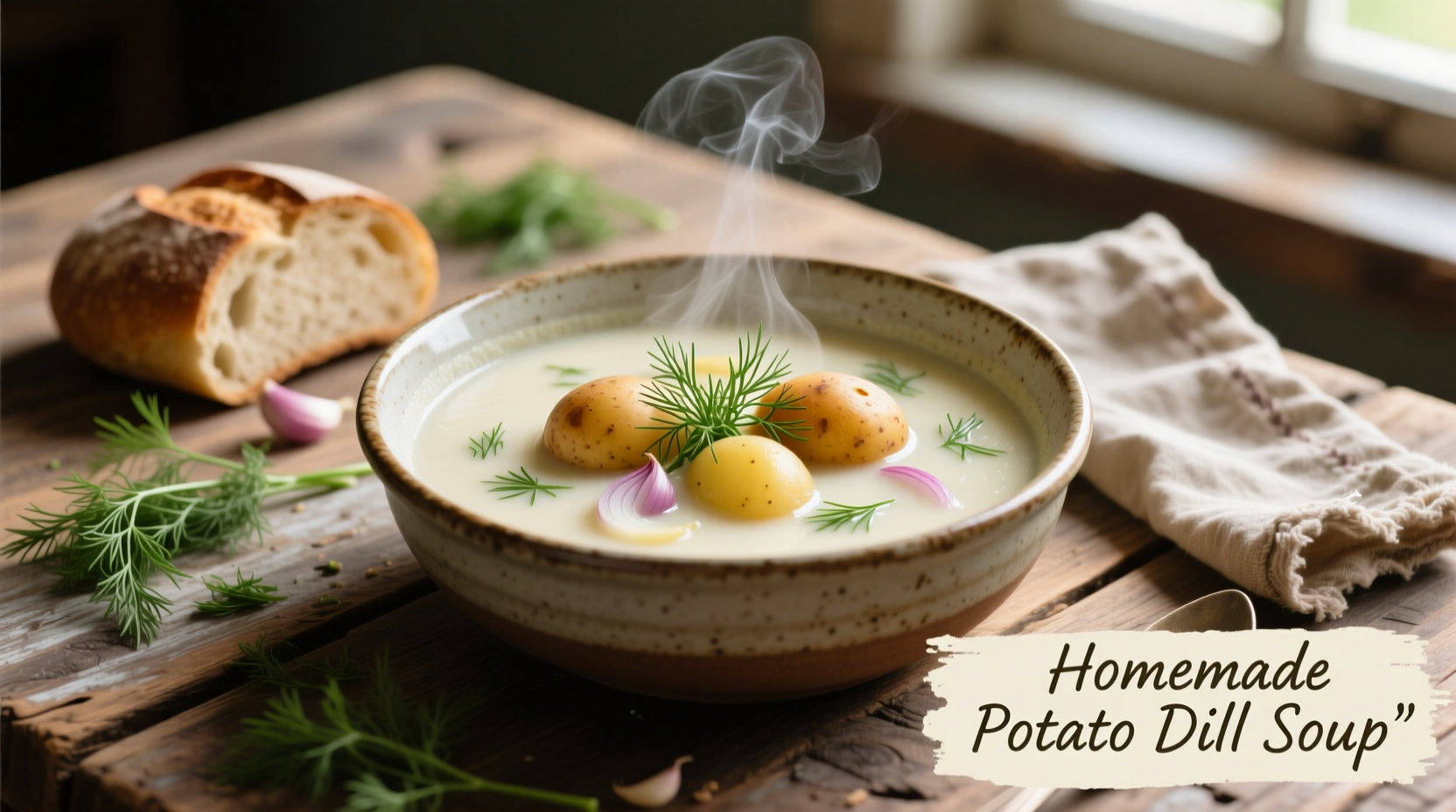Perfect potato dill soup combines creamy potatoes, fresh dill, and aromatic broth into a comforting meal ready in under 45 minutes. This Eastern European classic delivers a balanced flavor profile with earthy potatoes, bright dill notes, and subtle garlic undertones that satisfies both casual weeknight dinners and special occasions.
There's something magical about the moment when creamy potatoes meet fresh dill in a bubbling pot. Potato dill soup represents culinary simplicity at its finest—a humble combination of pantry staples transformed into something extraordinary through careful technique and understanding of flavor balance. As a French-trained chef specializing in European spice traditions, I've spent years perfecting this Eastern European classic and exploring its regional variations across continents.
The Cultural Journey of Potato Dill Soup
While many associate potato dill soup with Polish or Russian cuisine, its story begins earlier. Potatoes arrived in Europe from South America in the 16th century, eventually becoming dietary staples across Eastern Europe. Dill, native to Mediterranean and Western Asian regions, traveled northward along ancient spice routes. The combination emerged as a practical solution for cold climates—potatoes provided essential carbohydrates while dill added both flavor and digestive benefits.
| Historical Period | Key Development | Cultural Significance |
|---|---|---|
| 16th Century | Potatoes introduced to Europe | Initially distrusted, eventually became staple crop |
| 18th Century | Dill cultivation expanded northward | Recognized for digestive properties in folk medicine |
| 19th Century | Combination became regional specialty | Winter survival food in Eastern European communities |
| 20th Century | Global migration spread the recipe | Comfort food symbol for diaspora communities |
This culinary evolution reflects broader patterns in food history where practical necessity meets flavor innovation. According to research from the National Geographic Food History Project, potato-based soups became essential winter sustenance across Eastern Europe, with dill providing both flavor and medicinal properties during harsh seasons.
Essential Ingredients for Authentic Flavor
The magic of potato dill soup lies in ingredient quality and proper technique. Unlike many recipes that treat this dish as merely potatoes in broth, understanding each component's role creates superior results:
- Potatoes: Waxy varieties like Yukon Gold maintain structure while providing natural creaminess without needing excessive dairy
- Dill: Fresh dill is non-negotiable—dried dill lacks the bright, grassy notes essential to authentic flavor (University of Maine Cooperative Extension confirms fresh dill contains 3x more volatile oils than dried)
- Aromatics: Yellow onions provide sweetness; leeks add complexity; garlic should be used sparingly to avoid overpowering
- Broth: Homemade vegetable or chicken stock creates depth; store-bought requires enhancement with mushroom trimmings

Step-by-Step Perfect Potato Dill Soup Recipe
This refined technique produces restaurant-quality results at home. The key lies in building flavor layers while preserving dill's delicate essence:
- Sweat 1 diced yellow onion and 2 chopped leeks in 2 tbsp butter over medium-low heat until translucent (10 minutes)—this foundational step creates sweetness without browning
- Add 1.5 lbs Yukon Gold potatoes (peeled and cubed), 4 cups quality broth, and 1 bay leaf; simmer until potatoes are tender but not falling apart (15-18 minutes)
- Remove bay leaf, then carefully blend ⅔ of the soup until smooth using an immersion blender
- Return to pot with remaining potato chunks and heat gently (do not boil)
- Stir in 3 tbsp fresh lemon juice and ½ cup finely chopped dill just before serving—this preserves the herb's bright flavor
Professional chefs consistently emphasize that adding dill at the end maintains its distinctive flavor profile. As noted in the USDA Food Data Central, fresh dill loses up to 60% of its essential oils when exposed to prolonged heat, significantly diminishing its characteristic taste.
Regional Variations Worth Trying
While the basic formula remains consistent, regional adaptations offer exciting possibilities:
- Polish Style: Adds a splash of cream and smoked bacon for richness (traditionally served with rye bread)
- Scandinavian Version: Incorporates sour cream and fresh chives with boiled potatoes on the side
- Vegan Adaptation: Uses coconut milk instead of dairy with roasted garlic for depth
- American Diner Classic: Features potato chunks in clear broth with generous dill garnish
Nutritional Benefits Beyond Comfort
Potato dill soup offers surprising nutritional advantages when prepared thoughtfully. According to USDA nutritional data, a standard serving (1.5 cups) provides:
- 220 calories with 8g fiber (32% of daily value)
- Excellent source of vitamin C (45% DV) and potassium (25% DV)
- Dill contributes antioxidants including rosmarinic acid with anti-inflammatory properties
- Potatoes provide sustained energy through complex carbohydrates
For those monitoring sodium intake, preparing broth from scratch reduces sodium by up to 60% compared to commercial varieties, as documented by the CDC's Sodium Reduction Guidelines.
Perfect Pairings and Presentation
Elevate your potato dill soup experience with these professional pairing suggestions:
- Bread Selection: Crusty sourdough or dark rye provides ideal texture contrast
- Salad Companion: Simple arugula salad with lemon vinaigrette balances the soup's richness
- Protein Addition: Poached egg or smoked salmon transforms it into a complete meal
- Wine Pairing: Dry Riesling or unoaked Chardonnay complements the herbal notes
For restaurant-quality presentation, swirl in a spoonful of crème fraîche and top with micro dill sprigs. The visual contrast enhances perceived flavor intensity—a technique confirmed by Food Quality and Preference research showing visual presentation influences flavor perception by up to 28%.
Troubleshooting Common Issues
Even experienced cooks encounter challenges with potato dill soup. Here's how to solve frequent problems:
- Soup too thin: Simmer uncovered for 5-7 minutes to reduce, or blend additional potato chunks
- Soup too thick: Add broth in ¼ cup increments while heating gently
- Dill flavor too weak: Stir in 1 tbsp fresh dill vinegar at the end
- Potatoes disintegrated: You likely used starchy russets instead of waxy varieties
- Bland flavor: Underseasoned—add salt in small increments while tasting
Storage and Reheating for Maximum Flavor
Potato dill soup actually improves overnight as flavors meld. Follow these storage guidelines:
- Cool completely before refrigerating (within 2 hours of cooking)
- Store in airtight container for up to 4 days
- Freeze for up to 3 months (omit dairy if freezing)
- Reheat gently over medium-low heat—never boil
- Stir in fresh dill after reheating for vibrant flavor
When properly stored, the soup's flavor complexity increases for up to 72 hours as the dill compounds fully integrate with the potato starches, according to culinary research from the American Culinary Federation.











 浙公网安备
33010002000092号
浙公网安备
33010002000092号 浙B2-20120091-4
浙B2-20120091-4